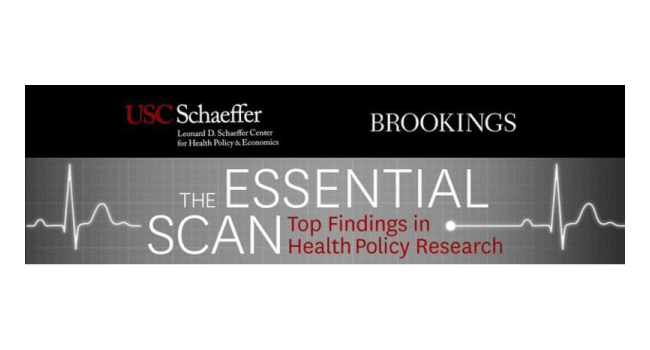What’s the latest in health policy research? The Essential Scan aims to help keep you informed on the latest research and what it means for policymakers. It is produced by the USC-Brookings Schaeffer Initiative for Health Policy, a collaboration between the Brookings Institution and the USC Schaeffer Center for Health Policy & Economics. To sign up to receive the Essential Scan straight to your inbox, sign up here.
Getting Americans Back to Work (and School) with Pooled Testing
White paper by: Darius Lakdawalla, Emmett Keeler, Dana Goldman, and Erin Trish
As communities across the country grapple with reopening, reliable and widespread COVID-19 testing will be a prerequisite. While frequent testing is an obvious solution, the cost of testing everyone would be prohibitive and supply might be limited. A new white paper outlines a cost-effective and scalable solution for this dilemma: Pooled testing. Under this strategy, labs would combine individual samples from employees of businesses (or students from schools) and process them in batches. If the pooled sample comes back positive for the coronavirus, individuals within the pool are re-tested. Likewise, if the pooled sample comes back negative, all individuals are cleared for that testing period. The researchers’ estimates suggest that pooled testing could lower testing costs by half or even three quarters for many schools and businesses. Understanding the prevalence of the virus in the population, as well as potential test-reliability issues, is important but even under different scenarios where this information was lacking, the modeling results were cost-effective. The researchers argue that pooled testing should be one component in a national strategy of testing and contact tracing. Full white paper here.
Most Patients Undergoing Ground and Air Ambulance Transportation Receive Sizable Out-of-Network Bills
Study by: Karan R. Chhabra, Keegan McGuire, Kyle H. Sheetz, et al.
Legislation at both the state and federal level is actively being considered to protect patients from surprise medical bills, but most attention has focused on billing by providers. A new study uses claims data from a large commercial insurer to measure the prevalence and financial impact of out-of-network billing in both ground and air ambulance transportation between the years 2013 to 2017. Researchers found that 71 percent of ambulance rides involved potential surprise bills. The out-of-network charges were substantially larger than in-network prices, by a median of $450 in ground transportation and $21,698 in air transportation. While air ambulances were more expensive, ground ambulance rides were significantly more common, so they had a larger aggregate impact of $129 million per year, versus $91 million per year for air ambulance. Ground ambulance billing is minimally regulated at the state and federal levels, but many rural states have attempted to regulate air ambulances, only to be struck down by courts citing the federal Airline Deregulation Act of 1978, indicating the need for federal action. The authors suggest that federal proposals to limit surprise out-of-network billing by physicians and hospitals should also include protections for patients who utilize ground or air ambulance transportation. Full study here.
Physician Prices and the Cost and Quality of Care for Commercially Insured Patients
Study by: Mark A. Unruh, Yongkang Zhang, Hye-Young Jung, et al.
A new study analyzes the relationship between prices paid to general internal medicine physicians and the cost and quality of care for insured adults. Researchers found the highest-price physicians were paid more than twice as much per service as the lowest price physicians. High prices for physician services may be justified if they lead to higher quality care. However, the researchers found little evidence that high-price physicians were providing higher-quality care for patients. Physician prices were measured and classified based on the allowed amounts for mid-level office visits, and adjusted for location. Total annual costs for patients seeing high-price physicians were 20 percent higher than the costs for patients of the lowest-price physicians, a difference not explained by differences in use. High price physicians tended to have a lower percentage of high-need patients attributed to them, and these patients did not have significantly lower rates of utilization of the two quality indicators used in this study. The authors conclude that differences in physician prices are largely attributable to market power, specifically the physician organization’s ability to leverage power when negotiating with health insurers. The authors suggest payers and policymakers seek ways to reduce physician prices to generate modest reductions in health care costs. Full study here.
The Impact of Medicare’s Mental Health Cost-Sharing Parity on Use of Mental Health Care Services
Study by: Benjamin Lê Cook, Michael Flores, Samuel H. Zuvekas, et al.
In 2008, Congress passed a law to phase in reductions in cost sharing for outpatient mental health services in Medicare, with the goal of putting them on par with other medical services. A new analysis looks at data from 2005-2015 (the phase-in period lasted from 2010 to 2014) to assess whether this reduction in mental health cost sharing was associated with changes in outpatient mental health visits and psychotropic medication fills. The parity policy was associated with significant increases in the overall use of mental health treatment among Medicare beneficiaries, compared to the privately insured, largely through higher rates of use of psychotropic medications. There was no detectable change in the use of outpatient visits for mental health services. These results are interesting, as the parity policy did not apply directly to medications, but specifically targeted cost sharing for outpatient mental health services. The researchers’ explanation for their findings was that cost-sharing reductions increased visits with primary care providers during which psychotropic medications were prescribed, but the visits themselves were not reported as being related to mental health. They conclude that the increased medication use could signal improvements in access to mental health care across Medicare beneficiaries. Full study here.
Click here to receive The Essential Scan email.
The Essential Scan is produced by the USC-Brookings Schaeffer Initiative for Health Policy, a collaboration between the Brookings Institution and the USC Schaeffer Center for Health Policy & Economics.
